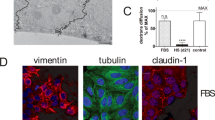Summary
We have established the human hepatoma cell line, HepG2, in a defined, serum-free medium. These cells were maintained and studied over a 100-generation period (i.e. 10 serial transfers). Cells maintained in serum-free medium exhibited growth parameters (i.e. saturation density, efficiency of plating, and population doubling time) similar to those obtained with HepG2 cells maintained in serum-supplemented medium. Serum-free cells were also similar to their serum-supplemented counterparts with respect to the expression of cathepsin B activity and the induction of aryl hydrocarbon hydroxylase by 2,3,7,8-tetra-chlorodibenzo-p-dioxin. Significantly, HepG2 cells maintained in serum-free conditions also retained the ability to synthesize and secrete proteins, including the liver plasma protein, apo-lipoprotein B. These results indicate that the serum-free medium used in this study supports the long-term growth and maintenance of human hepatoma, HepG2, cells in culture. Inasmuch as these cells retain phenotypes, including differentiated markers previously reported for their serum-supplemented counterparts, they may provide a more reliable, standardized culture system to study the expression, secretion, and regulation of proteins during biological and pathologic processes.
Similar content being viewed by others
References
Adeli, K.; Sinkevitch, C. Secretion of apolipoprotein B in serum-free cultures of human hepatoma cell-line, HepG2. FEBS Lett. 263:345–348; 1990.
Allen, R. E.; Dodson, M. V.; Luiten, L. S., et al. A serum-free medium that supports the growth of cultured skeletal muscle satellite cells. In Vitro Cell. Dev. Biol. 21:636–671; 1985.
Barrett, A. J. A new assay for cathepsin B and other thiol proteinases. Anal. Biochem. 47:280–293; 1972.
Bjare, U. Serum-free culture. Pharmacol. & Ther. 53:355–374; 1992.
Bottenstein, J. E.; Hunter, S. F.; Seidel, M. CNS neuronal cell line-derived factors regulate gliogenesis in neonatal rat brain cultures. J. Neurosci. Res. 20:291–303; 1988.
Bradford, M. A rapid and sensitive method for the quantitation of microgram quantities of protein utilizing the principle of protein-dye binding. Anal. Biochem. 72:248–254; 1976.
Darlington, G. J.; Kelly, J. H.; Buffone, G. J. Growth and hepatospecific gene expression of human hepatoma cells in a defined medium. In Vitro Cell. Dev. Biol. 23:349–354; 1987.
Dashti, N.; Wolfbauer, G. Secretion of lipids and lipoproteins by human hepatoma cell line, HepG2: effects of oleic acid and insulin. J. Lipid Res. 28:423–436; 1987.
de Launoit, Y.; Gasperin, P.; Pauwels, O., et al. Influence of fetal bovine serum and hormones on primary vs. long-term cultures of human breast cancers. In Vitro Cell. Dev. Biol. 27A:243–238; 1991.
Diamond, L.; Kruszewski, F.; Aden, D. P., et al. Metabolic activation of benzo[a]pyrene by human hepatoma cell line. Carcinogenesis 1:871–875; 1980.
Forster-Gibson, C. J.; Yu, X-F.; Dufresne, M. J. The aromatic hydrocarbon receptor for 2,3,7,8-tetrachlorodibenzo-p-dioxin and variable levels of induced aryl hydrocarbon hydroxylase activity in clones of the mouse hepatoma cells. Biochem. Cell. Biol. 66:1278–1286; 1988.
Freshney, R. I. Biology of cultured cells. In: Culture of animal cells. New York: Wiley-Liss, Inc.; 1987:7–13.
Hirobe, T. Melanocyte stimulating hormone induces the differentiation of mouse epidermal melanocytes in serum-free culture. J. Cell. Physiol. 152:337–345; 1992.
Hocman, G. Chemoprevention of cancer: protease inhibitors. Int. J. Biochem. 24:1365–1375; 1992.
Kelly, J. H.; Darlington, G. J. Modulation of the liver specific phenotype in the human hepatoblastoma line HepG2. In Vitro Cell. Dev. Biol. 25:217–222; 1989.
Kiss, R.; de Launoit, Y.; Danguy, A., et al. Influence of fetal calf serum in combination with pharmacological doses of progesterone or estradiol on proliferation and cell cycle kinetics of cultured mammary cancer cells. Oncology 49:391–399; 1989.
Knowles, B. B.; Howe, C. C.; Aden, D. P. Human hepatocellular carcinoma cell lines secrete the major plasma proteins and hepatitis B surface antigen. Science 209:497–499; 1980.
Labruzzo, P.; Xiao, F-Y.; Dufresne, M. J. Induction of aryl hydrocarbon hydroxylase and demonstration of a specific nuclear receptor for 2,3,7,8-tetrachlorodibenzo-p-dioxin in two human hepatoma cell lines. Biochem. Pharmacol. 38:2339–2348; 1989.
Laemmli, U. K. Cleavage of structural proteins during the assembly of the head of bacteriophage T4. Nature 227:680–685; 1970.
Mach, L.; Stuwe, K.; Hagen, A., et al. Proteolytic processing and glycosylation of cathepsin B. Biochem. J. 282:577–582; 1992.
Macri, J.; Adeli, K. Development of an amplified enzyme linked immunosorbent assay for sensitive measurement of apolipoprotein B in plasma and tissue culture media. Eur. J. Chem. Clin. Biochem. in press; 1993.
McFarland, D. C.; Pesall, J. E.; Norberg, J. M., et al. Proliferation of the turkey myogenic satellite cell in a serum-free medium. Comp. Biochem. Physiol. 99:163–167; 1991.
Mort, J. S.; Recklies, A. D. Interrelationship of active and latent secreted human cathepsin B precursors. Biochem. J. 233:57–63; 1986.
Moses, A. C.; Freinkel, A. J.; Knowles, B. B., et al. Demonstration that a human hepatoma cell line produces a specific insulin-like growth factor carrier protein. J. Clin. Endocrinol. & Metab. 56:1003–1008; 1983.
Okey, A. B.; Bondy, G. P.; Mason, M. E., et al. Temperature-dependant cytosol-to-nucleus translocation of the Ah receptor for 2,3,7,8-tetrachlorodibenzo-p-dioxin in continuous cell culture lines. J. Biol. Chem. 255:11415–11422; 1980.
Scher, W. Biology of disease. The role of extracellular proteases in cell proliferation and differentiation. Lab. Invest. 57:607–633; 1987.
Swartz, A. L.; Fridovich, S. E.; Lodish, H. F. Kinetics of internalization and recycling of the asialoglycoprotein receptor in a human hepatoma cell line. J. Biol. Chem. 257:4230–4237; 1982.
Teofili, L.; Sargiacomo, M.; Iovino, M. S., et al. Effects of a preformed extracellular matrix on long-term serum-free bone marrow culture. Ann. Hematol. 65:22–25; 1992.
Author information
Authors and Affiliations
Rights and permissions
About this article
Cite this article
Dufresne, M., Jane, D., Theriault, A. et al. Expression of cathepsin B and aryl hydrocarbon hydroxylase activities, and of apolipoprotein B in human hepatoma cells maintained long-term in a serum-free medium. In Vitro Cell Dev Biol - Animal 29, 873–878 (1993). https://doi.org/10.1007/BF02631366
Received:
Accepted:
Issue Date:
DOI: https://doi.org/10.1007/BF02631366




